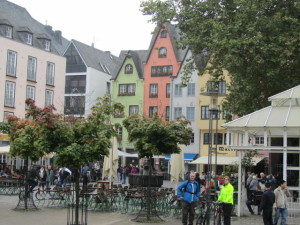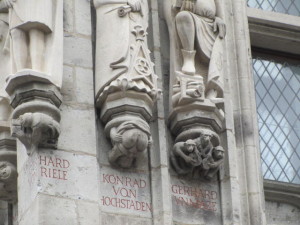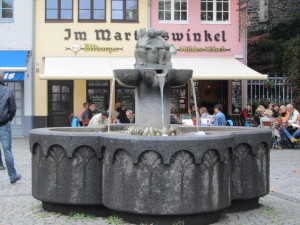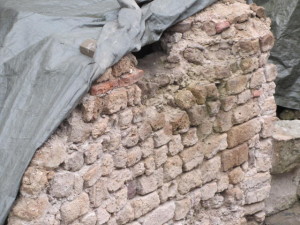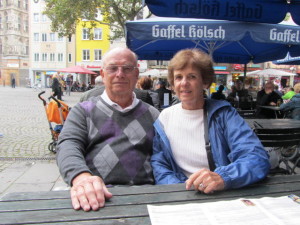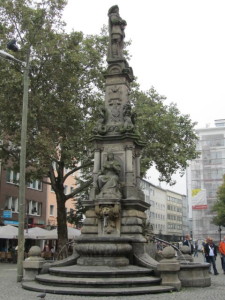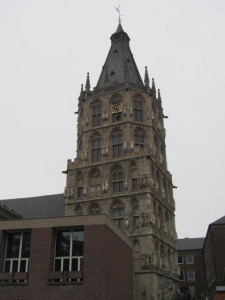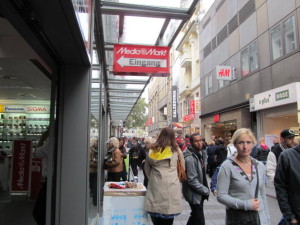purchase cytotec online Sometime about 1:30 AM, we entered another lock on the Rhine River. It didn’t bother us, but folks at breakfast mentioned bright lights in their window and bumping and swirling.
Sawangan We woke to a grey day, overcast and threatening. A visit to the fitness center was first on the schedule for me, then breakfast. We met some interesting folks at breakfast and Mike regaled them with tales of our barging trip through Burgundy and the locks we encountered on the Soane, the Little Soane, and Seille Rivers.
Later in the morning, we listened to a lecture on the Roman influence on the development of Germany. We approached Cologne (Koln) shortly before noon. From our vantage point at the restaurant, we watched as the crew worked to secure us to the wall.
Cologne is the largest city of Rhineland. The featured guided tour took us through squares in the oldest part of town, past oddities like unique rain spouts, down narrow streets and tiny squares. Our guide, Parthena (of Greek heritage), was engaging, very knowledgeable, and fun. She showed us newly discovered remains of a Jewish Synagogue and a Mikvah, currently being analyzed and studied. The town hall was built with a steeple like a church and featured statues of notables who had lived or visited. One was an Archbishop who wanted to be duke, but townfolk drove him out of town preferring a secular government. Of note, is the fact that pedestal holding his statue is a “moon.â€
Farina, a Italian who moved to Cologne, is credited with inventing eau de cologne. Scents previously had been oil based, he chose alcohol as his base, mixing it with bergermot, iris, and citrus. One significant advantage was that an alcohol based scent would not stain fine silk fabric. Among his famed customers were Marie Antoinette and, even, Bill Clinton.
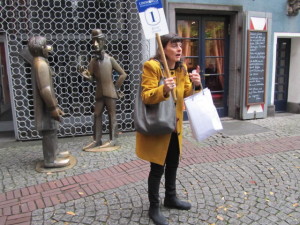 Our engaging delightful guide on our walking tour of Cologne, encouraging us to rub the nose of this bronze statue so we would return to Cologne
Our engaging delightful guide on our walking tour of Cologne, encouraging us to rub the nose of this bronze statue so we would return to Cologne
We walked on to Domplatte (Cathedral Square). First stop at the square was the Roman-Germanic Museum which exhibited relics to exemplify the history of Romans along the Rhine. The museum was built on the walls of Roman villa that was discovered in 1941. Exquisitely preserved is a mosaic of Dionysus that was the dining room floor. There were relics of every day life including: tombstones, arches, pottery, glass, and jewelry. Glass-blowing was an technique the Romans brought that took advantage of the natural materials of the area. An arch that has been displayed in the museum is the original arch for Colonia Claudia Ara Agrippinensium (the Roman name for Cologne, which was the capital of Lower Germania.) The mosaic floor was originally more intact, but a storm in 2007 drove lumber/boards through the windows and damaged sections that now appear as plaster sections with no features.
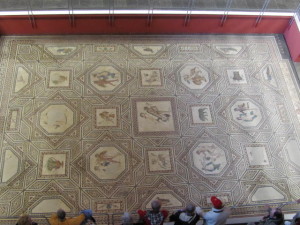
This floor was uncovered in 1941 an dis a mosaic floor of a dining room that dates to Roman times. It has achieved world-wide fame as Dionysis Mosaic
We left the museum and headed over to the Kolner Dom, the Cologne Cathedral. It is the largest cathedral in German,y, took over 600 years to build. Foundation laid in 1248, but after approximately a third was completed, construction ceased and did not start again until 1842. It was completed in 1880. Much of the stained glass is intact, surprising considering 95% of Cologne was destroyed in WWII. Photos were not permitted in the cathedral, as It was Saturday, the time for confessions.
Most of the exquisite stained glass is intact as well. We were told during WWII, it was removed to be preserved. According to lore, the church was built to accommodate the relics of the Three Wise Men. They are housed in a gold sarcophagus decorated with rubies and emeralds. The relics are only displayed on January 6th, complete with crowns.
We walked down a shopping street, found a sidewalk eatery to have a beer, then strolled back to the River Queen. We sat topside, chatting about our day, waiting for dinner service to start at 7PM. Dinner was exquisite and then to bed to prepare for the next day’s activities!

